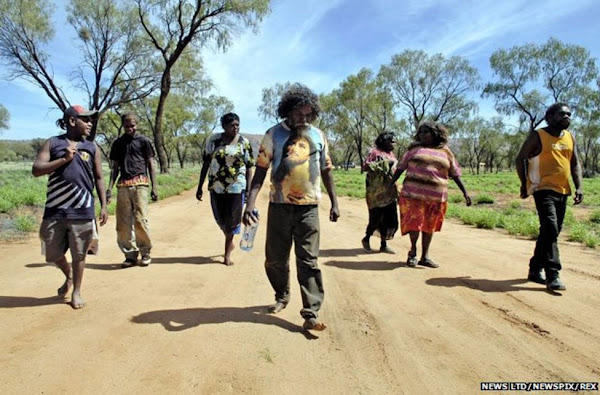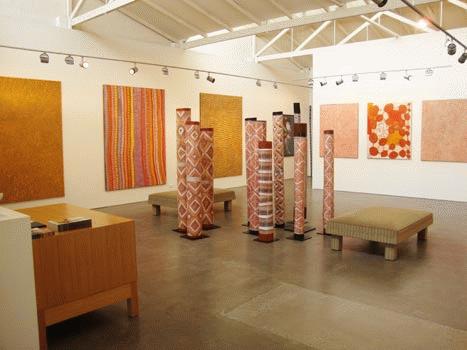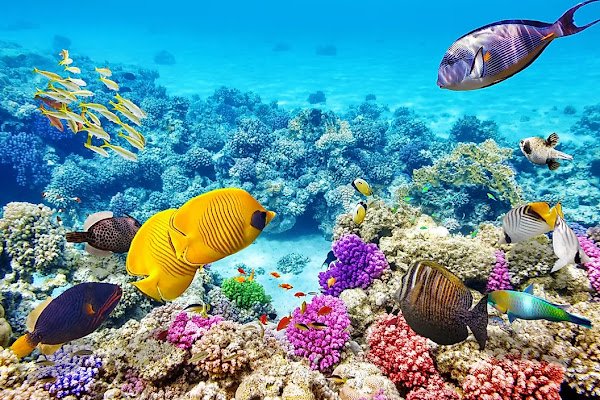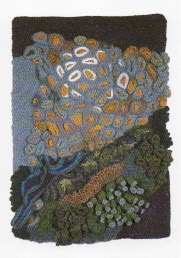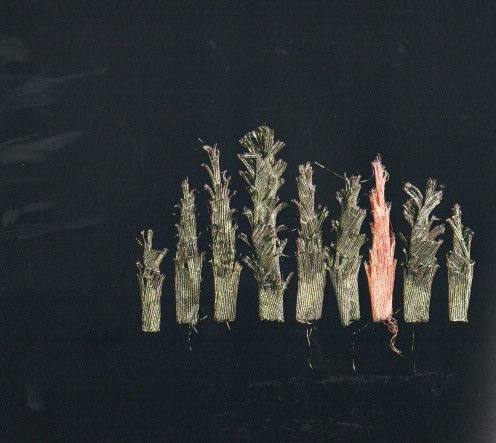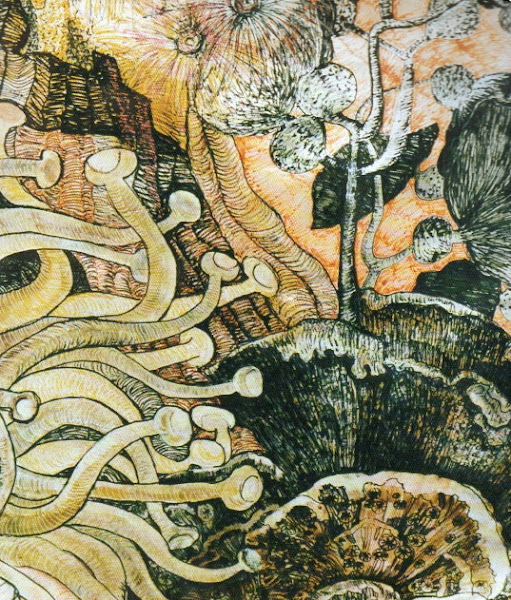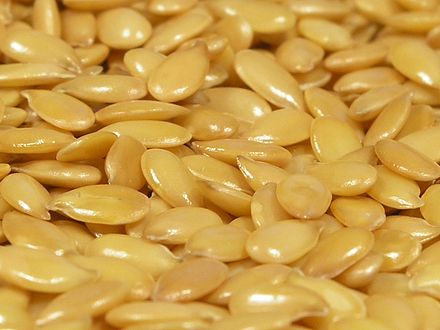Preamble
For your convenience I have listed below other posts on Australian aboriginal textiles and artwork.
Untitled Artworks
(Exhibition - ArtCloth: Engaging New Visions) Tjariya (Nungalka) Stanley and Tjunkaya Tapaya, Ernabella Arts (Australia)
ArtCloth from the Tiwi Islands
Aboriginal Batik From Central Australia
ArtCloth from Utopia
Aboriginal Art Appropriated by Non-Aboriginal Artists
ArtCloth from the Women of Ernabella
ArtCloth From Kaltjiti (Fregon)
Australian Aboriginal Silk Paintings
Contemporary Aboriginal Prints
Batiks from Kintore
Batiks From Warlpiri (Yuendumu)
Aboriginal Batiks From Northern Queensland
Artworks From Remote Aboriginal Communities
Urban Aboriginal ArtCloths
Western Australian Aboriginal Fabric Lengths
Northern Editions - Aboriginal Prints
Aboriginal Bark Paintings
Contemporary Aboriginal Posters (1984) - (1993)
The Art of Arthur Pambegan Jr
Aboriginal Art - Colour Power
Aboriginal Art - Part I
Aboriginal Art - Part II
The Art of Ngarra
The Paintings of Patrick Tjungurrayi
Warlimpirrnga Tjapaltjarri
Warlimpirrnga Tjapaltjarri[1]
Warning: This post might contain images of aboriginal persons who are deceased. If you are of an aboriginal heritage you may not wish to view or read this post.
Pintupi artist Warlimpirrnga Tjapaltjarri comes from Kiwirrkura. It is located 700 km west of Alice Springs (Australia), just over the border of Western Australia. The area was traditionally the home to the Pintupi people who identify themselves as being "people from the west" (of Papunya). From the 1940s, they were relocated by the government to the communities of Papunya and Haasts Bluff. By 1983 the aboriginal people were free to relocate to their "country" and so be near the numerous culturally significant sites such as Wilkinkarra (Lake Mackay), Ngami, wirrul and Marrapinti.
Kiwirrkura is one of the most remote of all Aboriginal communities. In early 2001 the entire community consisted of about 170 people. It is a great place to hunt, and many local people enjoy the luxury of their fertile hunting grounds which sit only a short distance from their community.
Pintupi artist Warlimpirrnga Tjapaltjarri is a man of unique understanding in his community. He was one of the "Pintupi Nine" (also erroneously referred to as the "lost tribe") - the last of nine indigeneous Australians living a nomadic and completely traditional existence who walked out of the desert in 1984. The story made headlines all over the world.
The day the Pintupi Nine entered the modern world by Alana Mahony, Kiwirrkurra (published on 23 December 2014).
In 1984 a group of Australian Aboriginal people living a traditional nomadic life were encountered in the heart of the Gibson desert in Western Australia. They had been unaware of the arrival of Europeans on the Australian continent, let alone cars or even clothes.
Just four years later Warlimpirrnga Tjapaltjarri presented a solo show of his paintings at the Gallery Gabrielle Pizzi in Melbourne (Australia).
Australian Art Gallery - Gallery Gabrielle Pizzi (Melbourne).
Initially hesitant as an artist, Warlimpirrnga Tjapaltjarri was encourgaged by the former manager of Papuunya Tula Artists, Daphne Williams and on exhibiting his 24 works, all were purchased by the Melbourne-based dealers Ron and Nellie Castan on behalf of the National Gallery of Victoria. The early success boosted the young artist's confidence and he set about painting in earnest. He quickly became a prominent aboriginal artist and exhibited in main venues throughout the Western world.
He was influenced by other great Papunya artists including Kanya Tjapangati and the visual minimalism emerging from some of the other painters of the time, namely, George Tjungurrayi, Mick Namarari, Ronnie Tjampitjinpa and Turkey Tolson. His paintings became more minimal and, at the same time, more sophisticated as he established himself as one of the most important artists of his generation.
Untitled (2009)
Materials: Acrylic on Belgian linen.
It’s not a customary feeling for Mr. Tjapaltjarri (his full name is pronounced war-lehm-peer-ing-ah jah-pal-jah-ree), who was the eldest male in his family in the desert and, as a healer and keeper of ancestral stories at the heart of the Pintupi people, is still a commanding presence in Kiwirrkurra, the community where he lives in the Gibson Desert. The paintings that have made him a sought-after figure in the Desert Painting movement, which arose in the 1970s and sowed international interest in Aboriginal art, are in one sense transcriptions of the stories. They seem abstract, made from thousands of dots — a signature of much Desert Painting. The dots form tight parallel lines that, when viewed close up, oscillate like those of a Bridget Riley Op Art painting, except more so, a visual equivalent of standing near a speaker that drowns out all the sound around it.
An untitled painting by Warlimpirrnga Tjapaltjarri in his show at Salon 94. He began painting on canvas in the 1980s after his family was “discovered” in the wild.
Credit: Karsten Moran,The New York Times.
Tingari Dreaming by Warlimpirrnga Tjapaltjarri from Kiwirrkurra, Western Desert.
Materials: Acrylic on Belgian Linen.
Untitled (2009)
Materials: Acrylic on Belgian Linen.
Untitled (2008)
Medium: Acrylic on Belgian linen.
Untitled
Medium: Synthetic polymer paint on linen.
Signature & Dated: Not signed nor dated.
Credit: Gift of the Art Gallery Society of New South Wales (1995).
Courtesy: The Art Gallery of NSW.
Reference:
[1] https://aboriginalartgalleries.com.au/artist/595-warlimpirrnga-tjapaltjarri
Preamble
For your convenience I have listed below posts on this blogspot that featured the artistic output of Helen Lancaster (my dear friend who passed away on the 11th February 2020).
Cane Toad Narrative (Exhibition - ArtCloth: Engaging New Visions)
Transformation. An Exhibition of Contemporary Textiles
Curator: Helen Lancaster
Floating: Art Exhibition @ Purple Noon Art And Sculpture Gallery
Celebration
The Barrier Reef Corporate Wall [1]: Art Cloth Panels
Helen Lancaster's - The Great Barrier Reef
Introduction [1]
Helen Lancaster's fascination with the Great Barrier Reef (Queensland, Australia) spanned some four decades. She was like Alice but exploring her wonderland, namely - the Great Barrier Reef.
Helen Lancaster.
Helen Lancaster's artistic playground, namely, the Great Barrier Reef.
Helen Lancaster's - The Great Barrier Reef [1]
The early period of Helen Lancaster's work generally had more subdued coloring, although her reaction to some of the reef's underwater creatures inspired her love of bright colors.
Title: 'Organic Reef in Blue', 1982.
Technique and Materials: Crochet. Wool and mohair.
Size: 122 x 92 cm.
Bright colors dominated her recent works. As she gained more confidence, she realized she needed to reflect her Australian heritage rather than follow the global trends of the time which focused on neutral colors.
She was fortunate in that her late husband, Eardley, was a professional photographer who taught that skill at a TAFE college. The access to photographic images in rich color had a major impact on Helen Lancaster's choice of color.
In her work,'Coral Forest', manipulated forms were created from a contrast of matt and gloss, smooth and hairy, opaque, transparent or translucent materials. Making the statement that "Strong tonal and textural work labels me as an organic creature."
Title: 'Coral Forest', 2000 (Soft Sculpture).
Technique and Materials: Machine embroidery and fabric manipulation.
Size: Columns range in height, 107 x 310 cm.
Title: 'Coral Forest' (Detail).
Title: 'Coral Forest' (Detail).
Title: 'Coral Forest' (Detail).
The Great Barrier Reef mostly inspired Helen to create soft sculpture artworks. However, it also inspired Helen's prize-winning 'Barrier Reef' wearable art.
Helen's aim in her prize-winning 'Barrier Reef' costume was to evoke the fragility of the precious environment, with coral polyps forming the garland top and coral formations the skirt. The choice of the long skirt was a reference to the early Christian missionaries' practice of requiring Pacific Islanders to wear long skirts and to refrain from swimming, thereby avoiding any reference to their bodies. The head-dress represents the poisonous scorpion fish, or zebra fish.
Title: 'Barrier Reef Surprise', 1990.
Technique and Materials: Machine embroidery with shirring.
Size: 100 x 91 x 11 cm.
Title: 'Barrier Reef Surprise', 1990 (Detail).
Title: 'Anchors Away' (from the exhibition - 'Where have all the fish gone?') 1995 (Detail).
Title: 'Clustered Coral with Nudobranch', 1990.
Technique and Materials: Twin needling.
Size: 23 x 28 cm.
Title: 'Where have all the fish gone?' 1995 (Detail).
Technique and Materials: Twin needling.
Size: 23 x 28 cm.
Title: 'Coral Flow' 2001.
Technique and Materials: Machine embroidery, twin needling on velvet.
Size: 61 x 51 x 10 cm.
Title: 'Coral Flow', 2001 (Detail).
Title: 'Crown of Thorns', Anemones & Clown Fish, 1995 (Detail).
Technique and Materials: Hand drawing on satin.
Size: 242 x 112 cm.
Reference:
[1] H. Lancaster, Portfolio Collection, Telos Art Publishing, Winchester, England (2002).
Preamble
There are a number of book reviews on this blogspot. For your convenience I have listed the book reviews below:
Textiles: The Art of Mankind - Mary Schoeser
The Pattern Base by Kristi O'Meara - Book Review
Stitch Stories - Cas Holmes
Creative Strength Training - Jane Dunnewold
World Textiles: A Concise History
Introduction
Mary Schoeser's trailblazing reference book, World Textiles: A Concise History (World of Art) that was first published in 2003 by Thames & Hudson has now been revised and updated to incorporate new research in the recently published 2022 edition of the book, also titled, World Textiles: A Concise History (World of Art)[1].
This review is solely limited to the current edition, and not with the revisions that were or were not incorporated with respect to the original edition. As such, it is intended to give only a glimpse into the content of the book rather than graphically detailing its narrative.
With respect to the updated edition of, World Textiles: A Concise History, Mary was asked to join in with a relatively new website - Discover the Best Books, created by Sam Shepherd. She says about the offer, 'I liked the idea because it allowed me to recommend five books that I really do think make a significant contribution to our understanding of textiles, so it wasn't just about me.'
To see Mary Schoeser's recommendations click here on the following link - The "Best books to get you hooked on textile histories By Mary Schoeser".
Mary Schoeser - World Textiles: A Concise History [1]
For many of us, who pride ourselves on having a textile library, Mary Schoeser would already be well known to you. She is internationally recognized as being a world authority on the history of textiles, as well as an international authority on the output of textile artists. Mary Schoeser’s international standing is well documented, from being an International Advisor to the Metropolitan Museum of Art (New York), to being the Honorary President of the Textile Society (United Kingdom) to currently being an Honorary Senior Research Fellow at the Victoria and Albert Museum. She is also Patron of the Bernat Klein Foundation and the School of Textiles, Coggeshall (click on the following link - School of Textiles). Her publications range from detailing materials and techniques in the decorative arts to monographs on such high-profile international textile artists as Norma Starszakowna (e.g., Telos Portfolio Collection).
Front Cover of Mary Schoeser's, World Textiles: A Concise History (World of Art).
There are ten chapters in this A5 288 page paperback edition, with an appendix featuring a glossary of terms, a chapter-by-chapter select bibliography, graphical and subject indexes as well as acknowledgements.
The scope and size of each chapter is informative since it gives the perspective buyer an insight of where the author’s emphasis lies in the management of her treatise.
The book is organized as follows:
Chapter One: 'Prehistoric Materials and Techniques' (pp 11-34);
Chapter Two: 'The Dye and Loom Age, c. 3200 - 600 BC' (pp 35-59);
Chapter Three: 'Trade and Trends, 750 BC to AD 600’ (pp 60-86);
Chapter Four: 'Church and State, 600 - 1500' (pp 87-109);
Chapter Five: 'Western Ideas and Styles Dispersed, 1300 - 1900' (pp 110-133);
Chapter Six: 'Oriental Influences, 1450 - 1900' (pp 134-156);
Chapter Seven: 'Surface Patterning from Indigo to Ikat, 600 - 1900' (pp 157-180);
Chapter Eight: 'The Importance of Cotton and Linen, 1500 - 1950' (pp 181-203);
Chapter Nine: 'New Technology and Fibres, 1600 to Today' (pp 204-229);
Chapter Ten: 'The Art of Textiles, 1850 to Today' (pp 230-255);
Clearly, Mary Schoeser has effectively scoped the most important keystones that one must address in order to better comprehend the historical as well as creative developments associated with textiles and their deployment.
What is critical in this scholarly, well written and therefore easy to read treatment are the excellent photographs that showcase the various ideas that are being espoused by the author to enhance the reader's learning experience. I have only reproduced one of the photographs in her book below and have used a low resolution of the image. This clearly illustrates that the author has selected photographs of high calibre and moreover, that are pertinent to her exposé of a particular idea and/or content. The many photographs in the book are very important to support the written exposé, which heighten the reader’s learning and/or enjoyment experience.
Comment [1]: 'Discovered in Denmark in 1921 and dated to 1390-1370 BC, Egtved Girl's garments include a short skirt made of cords, a construction that can be dated back some 25,000 years to the Upper Paleolithic through the appearance of string skirts on carved Western European 'Venus' figurines. Recent strontium isotope analyses of the wool used show it is not Danish; instead this young woman, about seventeen when she died, had travelled between southern Germany and a place in Jutland (Denmark) or northern Germany.'
This book has given me a far greater awareness of the historical timelines between when textiles first shook the world to its importance to this day. The past and present is what is showcased in this book, but it's the possible futures and reflections on environmental challenges that Mary has stitched into the veins of her narrative that will make it a lasting contribution. It is a must buy for textile artists and designers, fashion professionals, collectors, university and student libraries and moreover, for libraries in general. This text sits proudly in my library among some of the finest reference books on textiles that I possess!
I highly recommend that you purchase this important book for your textile library, or if you are a librarian, then purchase it to add to your library's collection for your members, and the public in general, to enjoy.
Reference:
[1] M. Schoeser, World Textiles: A Concise History, Thames & Hudson Ltd, London (2022).
Preamble
This is the sixteenth post in a new Art Resource series that specifically focuses on techniques used in creating artworks. For your convenience I have listed all the posts in this new series below:
Drawing Art
Painting Art - Part I
Painting Art - Part II
Painting Art - Part III
Painting Art - Part IV
Painting Art - Part V
Painting Art - Part VI
Home-Made Painting Art Materials
Quality in Ready-Made Artists' Supplies - Part I
Quality in Ready-Made Artists' Supplies - Part II
Quality in Ready-Made Artists' Supplies - Part III
Historical Notes on Art - Part I
Historical Notes on Art - Part II
Historical Notes on Art - Part III
Historical Notes on Art - Part IV
Historical Notes on Art - Part V
Tempera Painting
Oil Painting - Part I
Oil Painting - Part II
Oil Painting - Part III
Oil Painting - Part IV
Oil Painting - Part V
Oil Painting - Part VI
Pigments
Classification of Pigments - Part I
Classification of Pigments - Part II
Classification of Pigments - Part III
Pigments for Oil Painting
Pigments for Water Color
Pigments for Tempera Painting
Pigments for Pastel
Japanese Pigments
There have been another one hundred and thirteen posts in a previous Art Resource series that have focused on the following topics:
(i) Units used in dyeing and printing of fabrics;
(ii) Occupational, health & safety issues in an art studio;
(iii) Color theories and color schemes;
(iv) Optical properties of fiber materials;
(v) General properties of fiber polymers and fibers - Part I to Part V;
(vi) Protein fibers;
(vii) Natural and man-made cellulosic fibers;
(viii) Fiber blends and melt spun fibers;
(ix) Fabric construction;
(x) Techniques and woven fibers;
(xi) Basic and figured weaves;
(xii) Pile, woven and knot pile fabrics;
(xiii) Nainkage, durable press and wash-wear finishes;
(xvi) Classification of dyes and dye blends;
(xv) The general theory of printing.
To access any of the above resources, please click on the following link - Units Used in Dyeing and Printing of Fabrics. This link will highlight all of the one hundred and thirteen posts in the previous a are eight data bases on this blogspot, namely, the Glossary of Cultural and Architectural Terms, Timelines of Fabrics, Dyes and Other Stuff, A Fashion Data Base, the Glossary of Colors, Dyes, Inks, Pigments and Resins, the Glossary of Fabrics, Fibers, Finishes, Garments and Yarns, Glossary of Art, Artists, Art Motifs and Art Movements, Glossary of Paper, Photography, Printing, Prints and Publication Terms and the Glossary of Scientific Terms. All data bases in the future will be updated from time-to-time.
If you find any post on this blog site useful, you can save it or copy and paste it into your own "Word" document for your future reference. For example, Safari allows you to save a post (e.g. click on "File", click on "Print" and release, click on "PDF" and then click on "Save As" and release - and a PDF should appear where you have stored it). Safari also allows you to mail a post to a friend (click on "File", and then point cursor to "Mail Contents On This Page" and release). Either way, this or other posts on this site may be a useful Art Resource for you.
The new Art Resource series will be the first post in each calendar month. Remember - these Art Resource posts span information that will be useful for a home hobbyist to that required by a final year University Fine-Art student and so undoubtedly, some parts of any Art Resource post may appear far too technical for your needs (skip those mind boggling parts) and in other parts, it may be too simplistic with respect to your level of knowledge (ditto the skip). The trade-off between these two extremes will mean that Art Resource posts will be hopefully useful in parts to most, but unfortunately may not be satisfying to all!
Historical Notes on Art - Part V [1]
The Renaissance
The painting methods and materials of the Italian Renaissance are well documented and the technology of its various schools and individuals fairly well established: fresco, egg tempera, and oils.
A detail of 'A Crowned Virgin Martyr (St. Catherine of Alexandria)' by Bernardo Daddi.
The Northern painters are somewhat less well established; their early records are less often as a complete or treatise-like form; the members of their guilds were less restricted by a single, established mode of procedure, and they seem to have done more toward the development of new materials and processes.
'Danae' by Jan Mabuse. He was one of the most well-known romanticists. The influence of Michelangelo and Raphael is showcased in the use of mythology and nudity in this particular piece.
As Renaissance art styles moved through northern Europe, they were adapted to local customs. For example, in England and the northern Netherlands, the Reformation nearly ended the tradition of religious painting. In France, the School of Fontainebleau, which was originally founded by Italians such as Rosso Fiorentino, succeeded in establishing a durable national style. Finally, by the end of the 16th century, artists such as Karel van Mander and Hendrick Goltzius gathered in Haarlem in a brief but intense phase of Northern Mannerism that also spread to Flanders.
Öl auf Holz by Karel van Mander.
Size: 50 x 122 cm.
Another example of the proper interpretation and study of old writings has become a classic. Among the statements in Vasari's book, 'Lives of Painters', are to be found several statements which other evidence has since contradicted, inlcuding the credit he gives to Jan van Eyck for the invention of oil painting. As early as 1781 this was disproved, since the use of oil painting has long since been traced to a gradual development with far earlier beginnings. Yet so strongly did this legend impresss people's minds, strengthened by the writings of Flemish and Dutch historians after Vasari's first edition, that it still passes for truth in some quarters today.
Portrait of Margaretha by Jan van Eyck.
In fact the oldest known oil paintings were created by Buddhist artists in Afghanistan and date back to the 7th century AD. Oil paint was used by Europeans for painting statues and woodwork from at least the 12th century, but its common use for painted images began with Early Netherlandish painting in Northern Europe, and by the height of the Renaissance, oil painting techniques had almost completely replaced the use of egg tempera paints for panel paintings in most of Europe, though not for Orthodox icons or wall paintings, where tempera and fresco, respectively, remained the usual choice.
A detail from the oldest oil painting in the world (~ 650 AD) a series of Buddhist murals created in Bamiyan, Afghanistan.
Commonly used drying oils include linseed oil, poppy seed oil, walnut oil, and safflower oil. The choice of oil imparts a range of properties to the paint, such as the amount of yellowing or drying time. The paint could be thinned with turpentine. Certain differences, depending on the oil, are also visible in the sheen of the paints. An artist might use several different oils in the same painting depending on specific pigments and effects desired. The paints themselves also develop a particular consistency depending on the medium. The oil may be boiled with a resin, such as pine resin or frankincense, to create a varnish prized for its body and gloss. The paint itself can be molded into different textures depending on its plasticity.
Flax seed is the source of linseed oil.
Oils Commonly Used in Renaissance Art
(a) Drying Oils: any of a group of oily, organic liquids that, when applied as a thin coating, absorb atmospheric oxygen and polymerize, forming a tough, elastic layer.
(b) Linseed Oil: the yellow oil obtained by pressing the seed of flax. It is known to dry from the top down after forming a skin, and therefore takes many months to dry through completely after becoming dry to the touch. This oil contains Linoleic acid, an unsaturated fatty acid occurring as a glyceride (an ester). Early painters neutralized this acid by the addition of lime or other siccative additives so that it would not deteriorate the painting surface. Linseed also contains Linolenic acid which attributes to its yellowing but also to its desirable flexibility. Linseed oil was one of the very first drying oils to be used in varnishing and has become the predominant oil for paint vehicles and mediums through the ages due to its superior balance of qualities. The mass production of alkili refined linseed oil for industrial use has also made it the cost effective favorite for artistic use as well. However, the best form of the oil for the artist is cold-pressed. (Old Holland oil paints use cold-pressed linseed oil).
Linseed Oil.
(c) Walnut Oil: an oil early favored by oil painters for its drying properties, since it dries quickly and evenly throughout. Slightly aged nuts produce higher quality (purer) oil. Nut oil can become rancid in storage, impairing its usefulness as a medium and thereby making it less popular than linseed oil in earlier centuries. Its primary use has been as a vehicle for grinding paints; its tendency to yellow less with age made it a preferred oil for mixing whites and blues which were corrupted by yellowing oil such as linseed oil. Modern technology has made this oil easier to obtain and to preserve, thus making it more affordable for use in all colors.
Walnut Oil.
(d) Poppy Oil: derived from the seed of the poppy flower (Papaver somniferum), it is a fine drying oil when treated. Its light color makes it ideal for grinding whites and blues and many paint manufacturers use it so. However, poppyseed oil will yellow some, so that its superiority over linseed oil in this respect is not so great when compared with its weaknesses. The absence of linolenic acid in poppy oil is what adds to its lighter color, but also to its brittleness. It dries very slowly and forms films that are soft and spongy and have a greater tendency to crack when compared to those formed by linseed oil. It is therefore not to be used in complex or layered painting techniques and is best used for alla prima, or direct (one coat) painting. The reduced flexibility of the paint film means that a white ground in pure poppyseed should never be used in underpainting and, following the rule of more flexible over less flexible, cannot be painted over linseed ground whites in top layers. Although, added in small percentage (15 - 25%) to linseed-oil-ground paint, it can reduce stringing and add a buttery consistency to some pigments (such as ultramarine). One author states that, used in this manner, "...poppyseed oil might preferably be substituted for the essential oils (clove or spike lavender) when a slow-drying oil color is desired."
Poppy Oil.
(e) Other oils listed by early painters were Sesamine oil and the Egyptian oil Cicinum. Painters have also worked with the oil expressed from the seed of the Safflower plant, a thistle like composite herb, Carthamus tinctorius, native to the Old World, having large, orange-red flower heads. It is said to be unsound when layered with linseed oil, though some modern manufacturers use it to grind their whites. It generally has the same properties and problems as Poppyseed oil.
Sesamine oil.
Reference:
[1] The Artist's Handbook of Materials and Techniques, R. Mayer, (ed. E. Smith) 4th Edition, Faber and Faber, London (1981).


